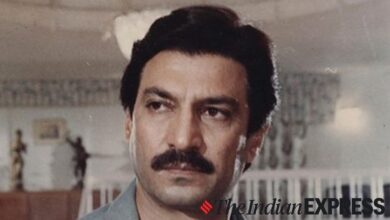‘Ray Between the Covers’: An exhibition that celebrates the filmmaker’s artic talent

The bullet was fired from such a close range that it pierced through the tiger and went out the other end — that’s how Jim Corbett took down the man-eater of Kumaon. Now imagine if its pelt was laid down as a trophy the hunting party, it would have two holes, one from where the bullet entered the tiger and the other from where it whizzed out. A graphic designer decided to zoom into the twin-holed pelt with his imaginary lens and use it as the front and back covers of a book on Corbett’s epic encounter. The result was an iconic book design (for the Bengali translation of Man Eaters of Kumaon, 1960s) that inspired generations of arts to literally have a storyboard that did justice to what lay between the covers.
Cover for the Bengali translation of Maneaters of Kumaon Jim Corbett
That designer was Satyajit Ray, whose aesthetic sensibilities were evidently revolutionary much before they informed his cinematic narratives. Though Ray is known for his multi-faceted genius — as a filmmaker, author, music composer, storyteller and children’s litterateur — the maestro was a pioneer of commercial art and design. Much before he became a filmmaker, Ray was an art, designing book covers, film posters and illustrating children’s books. Most importantly, he had a mastery over calligraphy and typography, creating new fonts in Bengali, receiving an award for designing the typeface for Ray Roman. It is this facet that has been showcased in the exhibition, Ray Between the Covers, at India International Centre in Delhi, which is celebrating the filmmaker’s centenary. Featuring 70 plus covers, it focusses solely on Ray as a book jacket designer, an area where his legacy is not known much, except in Bengal. Curator Indrani Majumdar says, “Ray’s artic work reflects a sophicated experimentation with various artic styles and traditions, both local and foreign, without compromising on the aesthetics or authenticity. Throughout his career, sketching, graphic design and calligraphy merged seamlessly with his filmmaking.”
Pagla Dashu (Loony Dashu); A collection of Schoolboy Stories; Pub: Signet Press 1946
Drawing on her personal collection and some pieces from Ray’s son and filmmaker Sandip Ray, Majumdar has arranged the collection thematically, from commissioned work for other publishers, to book covers of his own works and bound screenplays of his films like Kanchenjunga and Nayak. While many fans would have come across his illustrations of his children’s books and the Feluda series, they wouldn’t have known the first cover he designed for Signet Press, Khirer Putul (Cheese Doll, 1944) or the line drawings of anthologies of poetry of Jibananda Das and translated works of TS Eliot.
Our Films Their Films; Pub: Orient Longman 1976
It was his visual artry that made Ray the master storyteller he was. Each of his film scripts began with him sketching the scenes first. Says Majumdar, “From early childhood, Ray was acquainted with block printing and block carving techniques that he picked up at the family-owned printing press U Ray and Sons. In 1940, he joined Santiniketan to study art under Nandalal Bose and Binode Behari Mukherjee, who instilled in him a love for Indian classical art, reinforced a tour he took in 1941 to see the great masterpieces for himself. They helped him stay rooted to tradition while breaking stereotypes. The focus was on both originality and incorporating Indian accents in modern culture. Ray visited Ajanta, Ellora, Elephanta, Sanchi and Khajuraho, assimilating the qualities that dinguish Eastern from Western art. This sharpened his perception of the way very small details in Indian art could be used to express something much greater.”
Badshahi Aangti (The Emperor’s Ring, 1969)
As a graphic illustrator, Ray started his career in 1943 as a junior visualiser at D.J. Keymer (now Ogilvy), a British-run advertising agency where he established a strong reputation as an art director and designer. If he was working on punchlines for mundane items like biscuits, hair oils and cigarettes, he was also learning how to attractively package books with standout covers and jackets. His advertisements often reflected his familiarity with different folk motifs, traditional day-to-day rangolis (in Bengal, alpana) or the patachitra style of painting. At the same time, Ray ventured out as a book cover designer for the newly opened publishing house, Signet Press, where he designed some of his best hard-bound covers, revolutionising book jacket designs in Bengali literary traditions. “Do you know why Signet is significant? Because it was here that he got the assignment to do the layout, illustration and cover design of the abridged version of Bibhutibhushan Bandopadhyay’s Bengali classic Pather Panchali. One wonders if that process birthed the idea of his Apu trilogy,” adds Majumdar.
Professor Shonku; Pub: New Script 1965
With an impressive portfolio of 5,500 book covers, posters, advertisement layouts, film titles and innumerable illustrations for Bengali fiction, Ray completely overturned the conventional idea that a book design had to be staid and made it a medium of artic expression.
The exhibition gives a fair idea of how Ray was a pioneer of commercial graphic art in India. From his very first cover for Signet Press, Ray used folk art motifs, calligraphic details and brought an Indian sensibility to mainstream product design that had, till then, relied on Western templates. “He drew heavily on our country’s folk and tribal art traditions and scroll style paintings,” says Majumdar. Browsing the exhibition, you notice the use of bright solid colours in his work, something he probably did much before pop art guru Andy Warhol. “For him, the colour was about the moodboard. He often used turmeric, red, blue, saffron, green, pink, basically the vibrant shades of the Indian palette. But he could go stark according to the content. For example, the screenplay of Kanchenjunga has grey on the cover in keeping with the sobriety and the gravitas of the film’s frames,” adds the curator.
Often, he would play with lettering on his book covers, putting his calligraphy skills to good use. He would draw them, use brushstrokes, inlay them with textures and, in a pre-digital age, make his own typeface. In the initial years, he also designed the covers of his father’s (Sukumar Ray) books resurrected Signet Press in 1944. With the cover of Pagla Dashu (Loony Dashu), Ray has perfectly captured the face of the witty yet wilful character that Sukumar Ray created in the school boy series of stories featuring Dashu. Feluda looks sharp, alert, probing and suave, while Professor Shonku looks mysterious himself behind a flurry of his scientific inventions.
The exhibition offers a peek into Ray’s world of children’s literature. It may be fashionable to classify books today as child, teen and pre-adult, but Ray understood a child’s curious, adventurous and seeking mind better than any other writer of his time. He brought out the monthly children’s magazine, Sandesh, (a favourite Bengali sweet) that was founded his grandfather, author and entrepreneur Upendrakishore Ray in 1913. He edited it, designing cover and layouts, illustrating editions that comprised stories, essays, novels, puzzles, brainteasers, contests, and knowhows. The extent of his involvement can be judged from the fact that he answered the fan mail himself. He also did the cover for a 1961 literary magazine called Ekhon and conceptualised several others.
The exhibition brings to the fore Ray’s diverse, layered and innovative visual artry that, perhaps, he has not received due credit for, and an all-encompassing oeuvre that extended beyond his writings and films.
The exhibition continues till the end of the month at India International Centre, Delhi.








